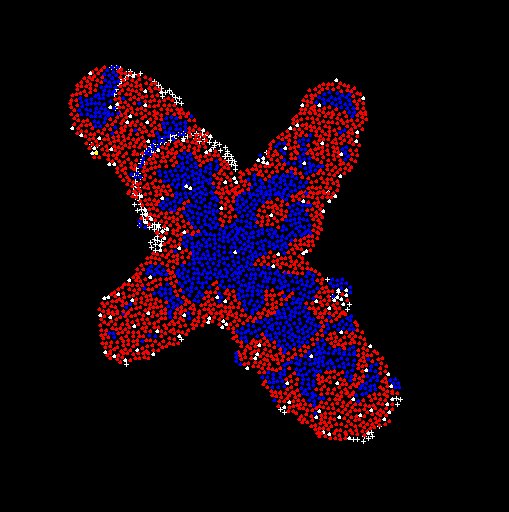
(movie of self-assembly)
Some Project Webpages:
- Self-Repairing Topological
Patterns
- Self-Assembling 2D
Shapes Using Primitives from Cell Growth
- Robust Methods for Distributed
Synchronization
-
Programmable Self-Assembly
NSF Grant Proposal
NSF Program on Quantum and Biologically Inspired Computing (QuBIC)
Amorphous Computing homepage
This research focuses on morphogenesis and developmental biology as a source of algorithms and general principles for organizing complex behavior from locally interacting individuals. We aim to design artificial systems that replicate biological robustness, and to use insights from these systems to understand the capabilities of biological systems. The goal is to be able to eventually formalize these general principles as programming languages --- with explicit primitives, means of combination, and means of abstraction --- thus providing a framework for the design and analysis of self-assembling systems.
We believe that the results from this research will have significant impact, not only on our engineering principles for robust design but also on our understanding of biological systems. These new programming models will impact the design of and approach to reconfigurable robotics, self assembly, and smart-matter applications. In the long run, these ideas may even help achieve coherent behavior from aggregates of biological cells. The biological comparisons will significantly improve our understanding of development and creation of morphology. Not only will this promote the use of computational models for understanding systems level biology, but it will also increase collaboration between computer science and biology in this area, where focus has traditionally been narrow.
Important organizational lessons can be learned from natural biological systems. Emerging technologies are making possible novel applications that integrate computation into the environment: smart materials, self-reconfiguring robots, self-assembling nanostructures. We are faced with the challenge of achieving coherent and robust behavior from the interactions of multitudes of elements and their interactions with the environment. These new environments fundamentally stress the limits of our current engineering and programming techniques, which depend on precision parts and strongly regulated environments to achieve fault-tolerance. By contrast, the precision and reliability of embryogenesis, in the face of constantly dying and replacing cells, variations in cell numbers, and changes in the environment, is enough to make any engineer green with envy. Our previous work demonstrated the potential of this approach with a programmable and robust process for shape formation on a sheet of identically-programmed ``cells'' using local primitives inspired by epithelial cell morphogenesis and Drosophila cell differentiation.
The goal of this project is twofold:
- To extend our programming models to new domains. We will design new languages that describe the formation of shape by exploiting replication (growth), motility, and deletion (cell death). Just as paper folding is a natural process for shape formation on a sheet, we will need to discover new models to describe shape formation in these new domains.
- To investigate the connection of our models to biological processes. Our previous work has exhibited several similar traits to biological systems and provided us with insights into how these systems may work. Specifically, we will investigate scale independence and morphological differences in closely-related species and also the connection between the kinds of failures observed in the simulated morphogenesis processes and those that occur in naturally-occurring birth defects, concentrating on failures of geometry, topology and synchronization.